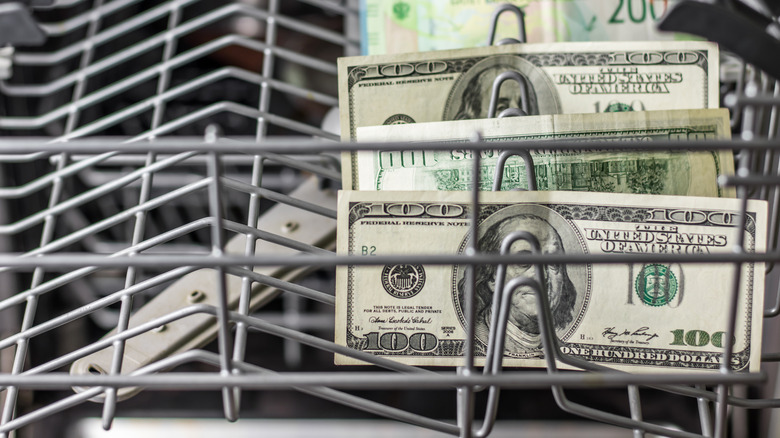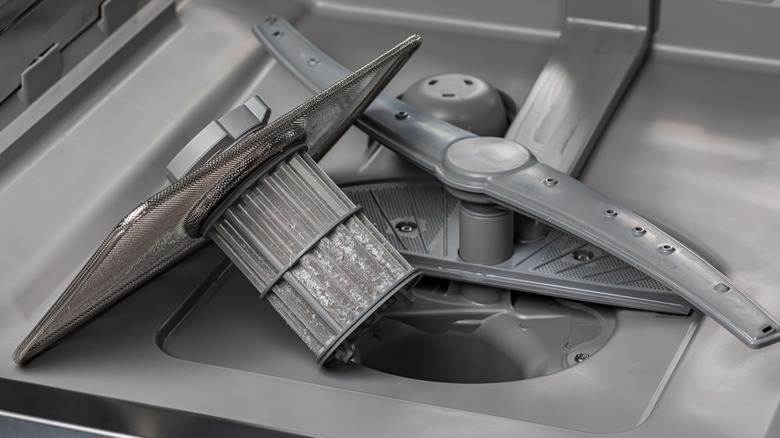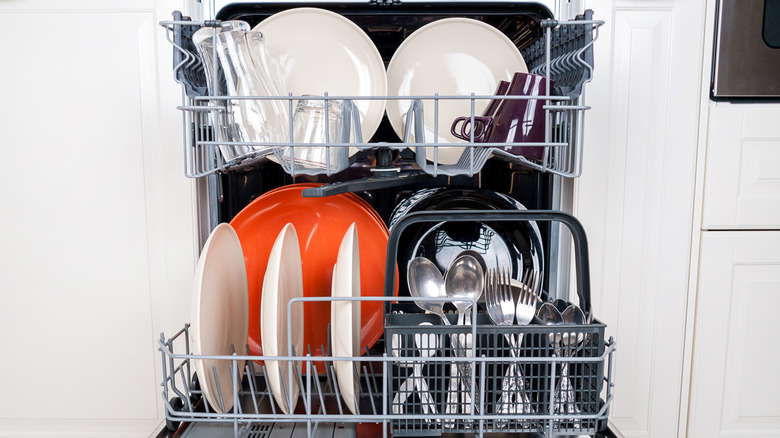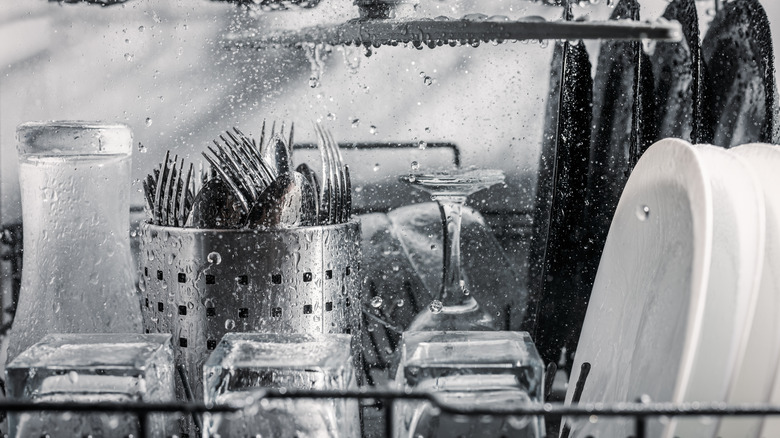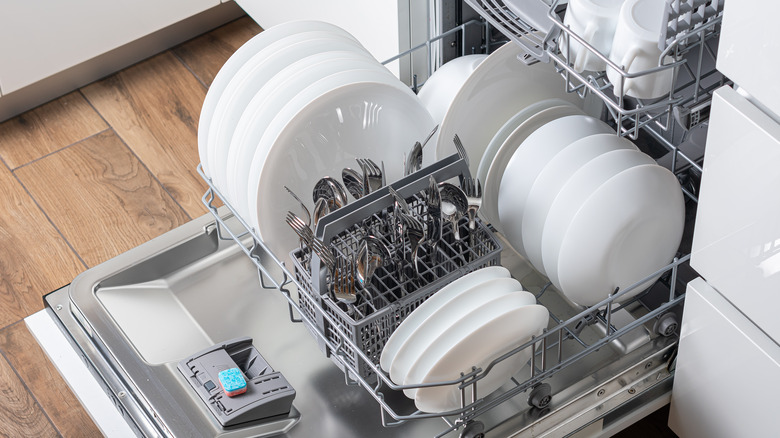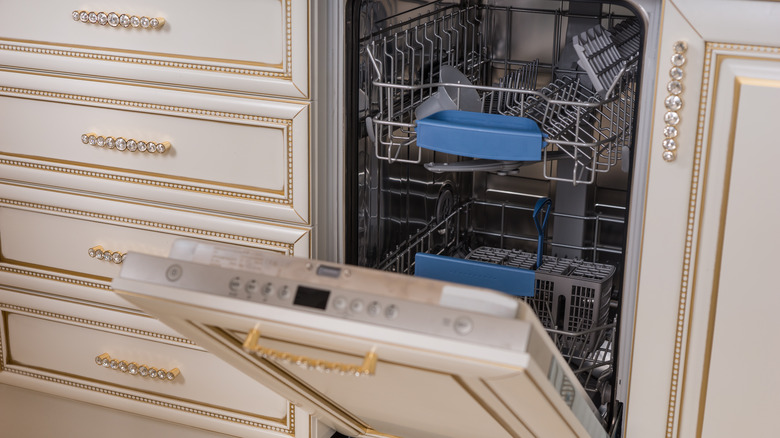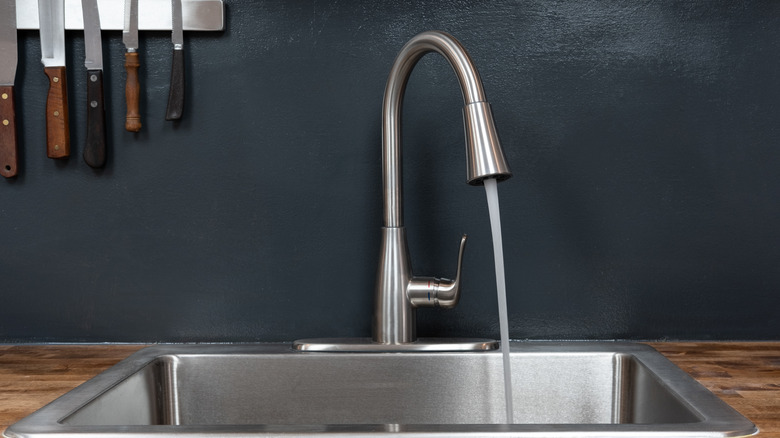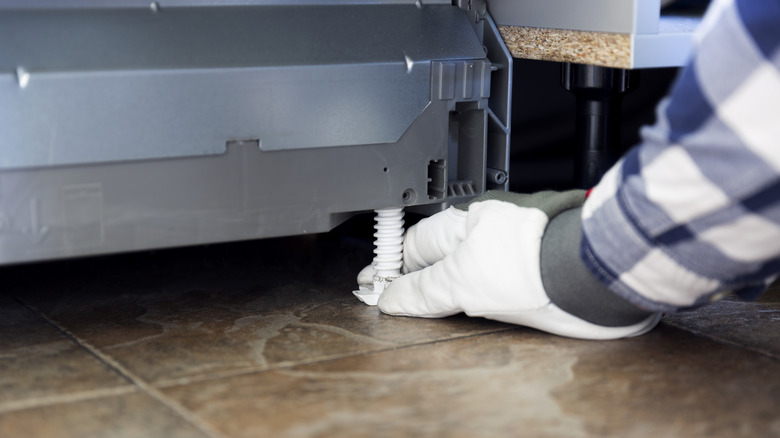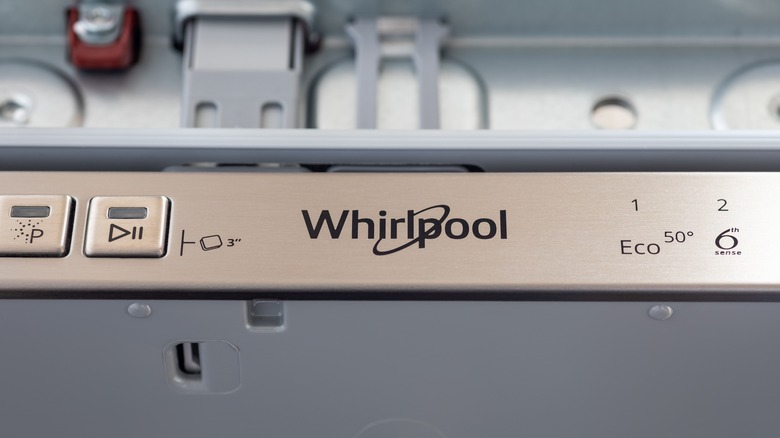Mistakes Everyone Makes When Buying Dishwashers
If you've done your homework, you know the best dishwashers are good at cleaning dishes. Reviewers never list poor cleaning performance as a con for the best-rated dishwashers, even budget ones. Avoiding purchasing mistakes is mostly a matter of juggling price and a long list of features and characteristics. The trick is to stay focused on what matters to you and your order of importance in terms of price, reliability, and ability to hide in plain sight.
One thing that can take you off-track is knee-jerk reactions to product features. For example, why let the need for a towel bar (or the preference for one) make you choose this feature over a cheaper model with a recessed handle? The latter is likely to blend in and not affect kitchen design overall. Why not consider features that make loading your dishwasher a breeze? According to Spencer's TV & Appliance, you can always add a hook for dish towels. Another example is an automatic door. Opening this dishwasher might sound like an excessive luxury at first, but the feature goes a long way toward delivering dryer dishes to you (via East Coast Appliance). Keep reading for a look at the mistakes everyone makes when buying dishwashers.
Spending less than you can afford
It's always a mistake to spend more than you can manage. However, when it comes to dishwashers, the opposite is also true. Don't spend less than you can reasonably swing. You might want to consider how long should a dishwasher really last. The average dishwasher lasts nine or 10 years, and more reliable models upwards of 20 years. So, this is a long-term investment. Don't be shy about spending an extra $100 or $200 because that cost can make all the difference in quality. Top-rated dishwashers rarely cost less than $500 and never less than $400. However, don't get carried away with spending. According to Consumer Reports, some unreliable brands can cost more than twice as much ($1,400) as one of their higher-rated dishwasher lines ($650). Look at it as saving $750 and getting an awesome dishwasher to boot.
Most online top-picks writeups feature a budget pick. This pick is somewhat more helpful than many of the other categories. If you bought the Samsung Storm because it won Best Smudge-Proof at HGTV, your priorities might be out of whack. We looked at HGTV, Cheapism, USA Today, Tom's Guide, and about 80 best-of lists from Appliances Connection and found that results were all across the board. Brands that wouldn't typically be considered, like Frigidaire and Amana, and other unreliable brands, stand out when you hold the price below $800.
Buying an expensive new fixer-upper
Reliability is a peculiar feature to discuss because its importance is absolute, but reliability is almost a negative if you aren't a fan of the device otherwise. If you're price-sensitive, don't shop on reliability alone, but always consider it a primary factor. It wouldn't be unreasonable to exclude entire brands from your search based on reliability issues across a few years and at least a few models. This tip will keep you from falling in love with a particular product line and disregarding reliability issues.
You might rule out entire brands based on reliability. REthority and Consumer Reports picked Samsung as their reliability super-villains. Samsung also appeared on the My Kitchen Mates list with commonly criticized brands Frigidaire/Electrolux, Viking, and Maytag. This Old House, Family Handyman, and REthority name Bosch and Whirlpool as consistently solid in terms of reliability. However, the U.S. Appliance Repair Affordability, Reliability & Seasonality 2019 report rates appliance reliability overall and found that Whirlpool took top honors, followed by Maytag and Kitchen-Aid (via Puls). Other outlets noted that these brands had reliability issues.
Ending up with clean, wet dishes
Dishwashers with poor drying performance are something too many of us are familiar with, and it can be a real problem. You have to hand-dry the dishes, set them out to dry, or let them dry by evaporation in the dishwasher. These inconveniences affect your time or your home's workflow. However, you can avoid these problems with a couple of drying performance pointers. One surprisingly effective feature that aids in dish drying is a stainless steel tub, which gathers condensation that would otherwise end up on your dishes. Stainless steel tubs have several benefits and might be considered a top feature on their own. According to Lowe's, stainless tubs are more durable and less prone to odors, loud noises, and ... wait for it ... stains.
Automatic opening dishwasher doors also help keep spots off glasses and silverware. They typically have a fan to keep the moisture from damaging items in your kitchen and provide a great way to know at a glance whether your dishwasher cycle is complete (via East Coast Appliance). On the other hand, Electrolux has devised a system to let you know when it is done with floor beam lights, turning your dishwasher into a '90s Mitsubishi Eclipse (via Colder's). Brands like Bosch, Kitchen-Aid, Thermador, and Maytag do the best job of drying dishes (via Don's Appliances). It's also good to regularly clean your dishwasher to keep it in tip-top shape.
I said your dishwasher is too loud! No, loud! Oh, never mind, I'll text you.
A loud appliance might not bother some people, but if it does, wow, does it ever bother you. The quietest dishwashers on the market are virtually silent, and some of the cheaper ones are nearly silent. However, the loudest are constantly irritating and disrupting. You can measure dishwasher loudness in decibels, and it's worth noting that decibel ratings are on a logarithmic scale, not a linear one. According to Pulsar Instruments, for every increase of three in decibel ratings, loudness roughly doubles. For every increase of 10 decibels, the sound increases by a factor of 10. A decibel rating of 53 is twice as loud as one of 50.
A rate of 45 decibels is similar to quiet library conversations, while 50 decibels is about the level of an average chat, and the rates in-between compare to the sound of rainfall (via Lowe's). These are clearly not people from South Florida. Designer Appliances, Reviewed, and Soundproof Living bring unique perspectives to their lists of the best quiet dishwashers but found that Miele, Bosch, and Kitchen-Aid make the best noise-conscious models. The winners ranged from dB ratings of 38 to 52.
Thinking of special dishwasher cycles like unicycles
It's tempting to think of those kooky cycle settings on newer dishwashers as trendy nonsense or unnecessary bloat, but all of those settings have a purpose. Well, most do, anyway. Some of them, like rinse and hold, become virtually indispensable after you've tried them once. As reported by Lowe's, rinse and hold is a cycle that rinses off dishes without dishwasher detergent, then waits for you to fill up the dishwasher or otherwise become ready to run the actual cleaning cycle.
Some cycles are just common sense. For example, how can you wash baby bottles without a sanitizing cycle? Polar opposite cycles like gentle and pots and pans seem like they should come standard on all dishwashers. Other cycles are genius because they accommodate how you actually use a dishwasher. A half-load cycle, which cleans only the top or bottom rack, certainly seems like something you would use from time to time (via Appliances Connection). Think about your lifestyle and average day, and keep that in mind while shopping for a dishwasher.
Buying a dumb dishwasher ... or a genius dishwasher
Smart home devices are all the rage, and we forgive you for rolling your eyes at the newest smart devices like smart water bottles, water pitchers, forks, and umbrellas. According to Insider, most of these replicate features available in free phone apps. They command your attention due to their expensive price tag. The smart umbrella, for example, is so pricey that it requires a built-in GPS tracker. The same is true for smart dishwashers. However, there's some good stuff out there, too.
Let's start with what smart means. We're not focusing exclusively on appliances connected to your phone or home automation systems, but devices that learn and make decisions with more intelligence than the previous generation of dishwashers. Successful smart dishwasher features center around smartphone control, energy consumption, and integration with home automation platforms (via Lifewire). Automatic detergent reordering should be as necessary and failure-proof as a zeppelin (via CNET).
Of course, too many features can turn into noise, needless expense, and fragility. Sometimes, things just don't work. GE innovated by making the first dishwashers that automatically dispensed detergent, which seems necessary for automatically running and remotely controlling dishwashers (via General Electric). However, they don't make any today after many, many, many accounts of the SmartDispense system clogging. If only GE could have figured out how to accomplish that in a $1,500 device for washing dishes.
It's hard to load, but at least it doesn't hold much
Loading features make up the bulk of a dishwasher's interface and ultimately influence how successful the machine is. A poorly loaded dishwasher will only ever get dishes clean by accident. According to Forbes, the third rack gives you an option for smaller items. Another feature is improved wine glass stem holders, which protect your glasses if you've graduated from Solo cups (via CNET). If you eat a sandwich one day, a large pot of crab boil the next, and a giant paella on Thursdays, you might benefit from adjustable racks (via The Spruce). Some dishwashers offer wash zone areas, which clean your dishes more thoroughly. The rest is an unwashed zone. An add-a-dish feature lets you put one last thing in after the cycle starts (via Appliances Connection).
If the loading options seem limitless, capacity options make up for it. Standard-sized dishwashers vary from 10 to 12 place settings (via Whirlpool). Place settings include a large dinner plate, bowl, small snack plate, coffee cup, saucer, drinking glass, knife, dinner fork, salad fork, and two teaspoons. If you're going through 12 of those a day, consider letting your foods touch each other. A machine's capacity determines how many things it can clean, not how much you can cram inside. Loading well is the key.
Letting your friends know you wash dishes
The next tip might sound silly, but that's only because it is a little silly. The control panel location, which is typically either on the front of the dishwasher or top of the door, is a top priority for many people. Ultimately, it's about design. Top-control dishwashers look more seamless within your cabinetry. Front-control dishwashers keep controls and displays visible. According to Lowe's, if you don't want the benefits of either approach, you can opt for semi-hidden controls on some models.
The problem with concealed control panels is that you can't see how much time remains in the cleaning cycle (via Forbes). Flat, concealed controls are easier to clean, presumably because they are flat (via Maytag). One issue is that the top ones can be difficult or impossible to access without opening the door in some installations. Yes, it's a bit silly, but if you're spending $2,400 on a dishwasher, it should look exactly how you want. It really should cook and plate your food too, and maybe tell you where you left your smart umbrella.
Not considering the design
Silly or not, design is a top priority for some people, and color is the mother of all design rabbit holes. According to Smad, if your favorite colors don't look right on a dishwasher, go for white, black, or stainless steel. Materials-wise, you're limited to stainless steel, plastic, and panels that match your cabinetry and insert into integrated dishwasher doors. Dishwashers with recessed handles blend in more easily (via Spencer's TV & Appliance).
Ideally, the dishwasher in your home should blend with your kitchen's overall design and aesthetic. Many dishwashers can be unimaginative and look the same. One exception is the lineup from Smeg. If you can look past the fact it was named the "worst fridge ever" in a brutal review that criticized the temperature stability and high energy use (via CHOICE), their dishwashers are generally well-reviewed. The cool retro '50s aesthetic and styling has earned the company a cult following.
Wasting water washing your 20-gallon pasta pot
When buying a new dishwasher these days, it's essential to consider its environmental impact. The good news is that modern consumer dishwashers are extraordinarily water- and energy-efficient, at least when compared to older models. These were like little car washes that came with high water volume and deformed your Tupperware with the heat of 1,000 suns.
According to Forbes, the EPA's Energy Star program certifies machines that reduce water consumption from the 5.8 gallons-per-cycle maximum to a new ceiling of 3.2 gallons. You can check out a list of all Energy Star certified dishwashers, including power and waste consumption figures to ensure your dishwasher is efficient and kind to the environment (via Energy Star). It's worth noting that the potential savings for upgrading to an Energy Star-rated dishwasher (as opposed to carefully maintaining an older one) are about eight bucks a year, or $80 over the life of the average dishwasher (via Lifehacker).
Remodeling your kitchen to fit the dishwasher
Generally speaking, there are two primary dishwasher types, including those that fit into a category and those that don't. However, depending on who you ask, you'll learn that there are actually two, three, five, or more types of dishwasher, and it only gets more confusing. Excluding portable and countertop models, dishwashers typically measure 18 to 24 inches. A handful of models are over 24 inches wide but still fit under standard counters. According to Spencer's TV & Appliance, ADA-compliant models exist for installation with shorter-than-usual counters. 18-inch dishwashers are becoming more popular lately, probably due to more people staying at home during quarantine (via Consumer Reports).
Given this homogeneity, shopping for dishwasher size is a matter of determining if your space is 18 or 24 inches wide. Outside of apartments and smaller houses, most of us will have 24-inch dishwashers. While there's not much that can go wrong, measure everything carefully (via Aztec Appliance). Check the width of your space at the top and bottom and the height on the left and right. Then, compare your dishwasher options to the smaller numbers.
Why would I want frigid air in my dishwasher?
Dad jokes aside, one way to simplify your shopping process is to look at which brands offer the things you value. There are some features common to particular manufacturers. Bosch, for example, is known for efficient and sanitary dish drying, and all its dishwashers use condensation rather than heating elements to get the job done. Miele has models that also dry without a heating element. However, according to Wirecutter, they tend to leave plastic items damp, which might not be something you're willing to tolerate in a $1,300 dishwasher.
Perhaps the clearest example of having your brand tied to a feature is Fisher & Paykel, currently the only manufacturer of drawer dishwashers (via Consumer Reports). Whirlpool is known for its soil sensor technology, which measures the dirtiness of your dishes (via Appliances Connection). Some go overboard and brand everything their dishwashers do, whether or not they do it well. For example, LG has technologies called QuadWash, TrueSteam, and ThinQ. These do mundane things slightly differently from the thousands of non-QuadWash, non-TrueSteam, and non-ThinQ models around.
Not trusting the experts, or the professional reviewers
Most people have a system for determining what to buy. Some always buy the middle-priced option, require three friend recommendations for the same product, or only buy items with 4+ stars and 1,000+ reviews on Amazon. Some ask their cats. Others always trust the advice of online experts — the only 100 percent wrong approach. A better strategy is to read reviews you can trust (not on manufacturers' sites), especially the negative ones, and compare that to the advice from the best dishwasher posts online. Read the methodology section to understand the dishwasher evaluation process. For example, Good Housekeeping reports spending four months testing 17 different dishwashers. The tests focus on capacity, ease of loading racks, and the drying cycle.
Eventually, patterns start to emerge. It's always possible for a particular model to go astray, but Miele, Bosch, and Whirlpool generally make highly regarded dishwashers. Fans of luxury will want to look into Miele or Bosch products, while the others should investigate Whirlpool and Bosch's less expensive models. Even questionable brands sometimes have a hit without the company's usual shortcomings. Keep a healthy skepticism as you research. Worst Brands does a decent meta-analysis of consumer reviews, but it references two metrics (cleaning power and washing power) that don't seem to exist. There's no replacement for doing your homework.

